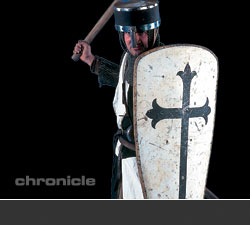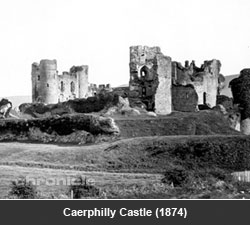
Castles and Conquest
In A.D. 1066, a Norman invasion fleet landed at Kent. Sixteen days later the Norman army defeated the English at Hastings. On Christmas Day 1066, Duke William of Normandy was crowned King of England. Twenty years later the total conquest of England was complete. William's policy of conquest did not extend to Wales. Instead, individual Norman Lords hungry for land were encouraged to conquer the Welsh Kingdoms one-by-one. Norman incursions into the modern county borough probably began in the late eleventh century. These were led by Robert fitz Hamo from his base at Cardiff. He soon gained control of the lowlands and these became the Lordship of Glamorgan. The uplands remained under Welsh control and fitz Hamo had no wish to face his enemies in these treacherous lands. When he did venture into Gelligaer in 1094, he is said to have suffered a humiliating defeat.
The following two centuries were a time of Welsh defiance and great unease. Wales was now divided into the territory held by the Welsh - the 'Pura Wallia'; the territory held by the Normans - the 'Marchia Wallia' and finally the land intermittently held by either side. Gains and losses on both sides where made through the might or weakness of individual leaders and through alliances and marriage. Disputes regularly occurred, such as the one that resulted in Ifor Bach's daring exploits in the mid-twelfth century. After a dispute over land, Bach of Senghenydd was said to have scaled the walls of Cardiff Castle. He then kidnapped the Earl of Gloucester and his family and held them captive until the dispute was settled.
Dating to this time of unease are a number of earthen castle mounds in the south of the county borough, such as at Twmbarlwm, Cwmcarn; Coed Craig Ruperra, Draethen and Twyn Castell, Gelligaer. Often described as Norman motte and bailey castles, their origin and date is not clear. It is possible that some were Norman and were built during fitz Hamo's first push into Welsh territory. Others may have been raised in the twelfth to thirteenth century in a bid to protect the frontier between the Welsh and Anglo-Norman territories. These may have been raised by either side. Perhaps the motte and bailey at Coed Craig Ruperra played this role. Other sites may have been the strongholds of the Welsh within their own territory, such as Twyn Castell, the reputed seat of the Lords of Senghenydd.

In 1217 the Lordship of Glamorgan passed to the de Clares. They were not content to restrict their Lordship to the lowlands and so began to conquer the surrounding uplands. However, their conquest was not absolute and vestiges of Welsh rule remained. The most powerful of these was the Lordship of Senghenydd which was now made-up of the 'commottes' of Uwch Caiach and Is Caiach. When Earl Gilbert de Clare became Lord of Glamorgan in 1263, he rightly saw this Welsh Lordship as a threat. In 1267, he launched an attack on the Lordship of Senghenydd and captured its leader Gruffydd ap Rhys. This brought him into direct conflict with Llywelyn ap Gruffydd, the Welsh Prince of Wales. Llywelyn saw himself as the Welsh overlord. Thus in simple terms, an attack on his countrymen and territory at Senghenydd was a direct challenge to his rule. De-Clare was well aware of the probable repercussions of his actions and the threat that could ensue. Hence in 1268, de Clare ordered the building of Caerphilly Castle, this located well within the territory of Is Caiach. Understandably provoked, Llywelyn ap Gruffydd pushed his army into northern Senghenydd. Bloodshed was averted when the Crown stepped in to mediate. However in 1269, Llywelyn ran out of patience and destroyed the unfinished Castle. De Clare eventually fended off this attack and pushed Llywelyn north. During the following standoff, Anglo-Norman resistance to Llywelyn grew. Threatened by this, Llywelyn retreated to Brecon. He never returned to Caerphilly and was now destined to confront the King himself.
By no means beyond the gaze of the Normans was the Welsh Church. Unimpressed by what they saw, they set about reforming it. By the late twelfth century, past practice had been swept away and a new order established. There were now four new diocese across Wales, each divided into parishes. The modern county borough fell within the diocese of Llandaff. At the head of this new Church sat the Archbishop of Canterbury. There then followed an unprecedented programme of church building, which lasted through to the mid-fourteenth century. Many of the county borough's older church buildings date to this time, such as St. Barrwgs Church, Bedwas. Also with the Normans came the foundation of the great Cistercian abbeys. The Cistercians were dedicated to the rule of St. Benedict and lived a life of poverty, simplicity, isolation and silence. In 1179 Llantarnam Abbey was established and this lay four miles to the east of the county borough. Like all abbeys, it relied upon its outlying farms to provide it with the provisions needed to sustain its monks. These farms were known as monastic granges. These were tended by lay brothers, who would grow crops and raise animals, especially sheep. Llantarnam held a grange at Cefn Rhyswg above Cwmcarn.
Image date: unknown
Location: unknown
Submitted by: unknown
Do you have any stories, images and interesting facts relating to this picture. Help Chronicle build a website of your Caerphilly County Borough memories. Email the webmaster telling us as much as you can about your pictures. Thank you
Description: